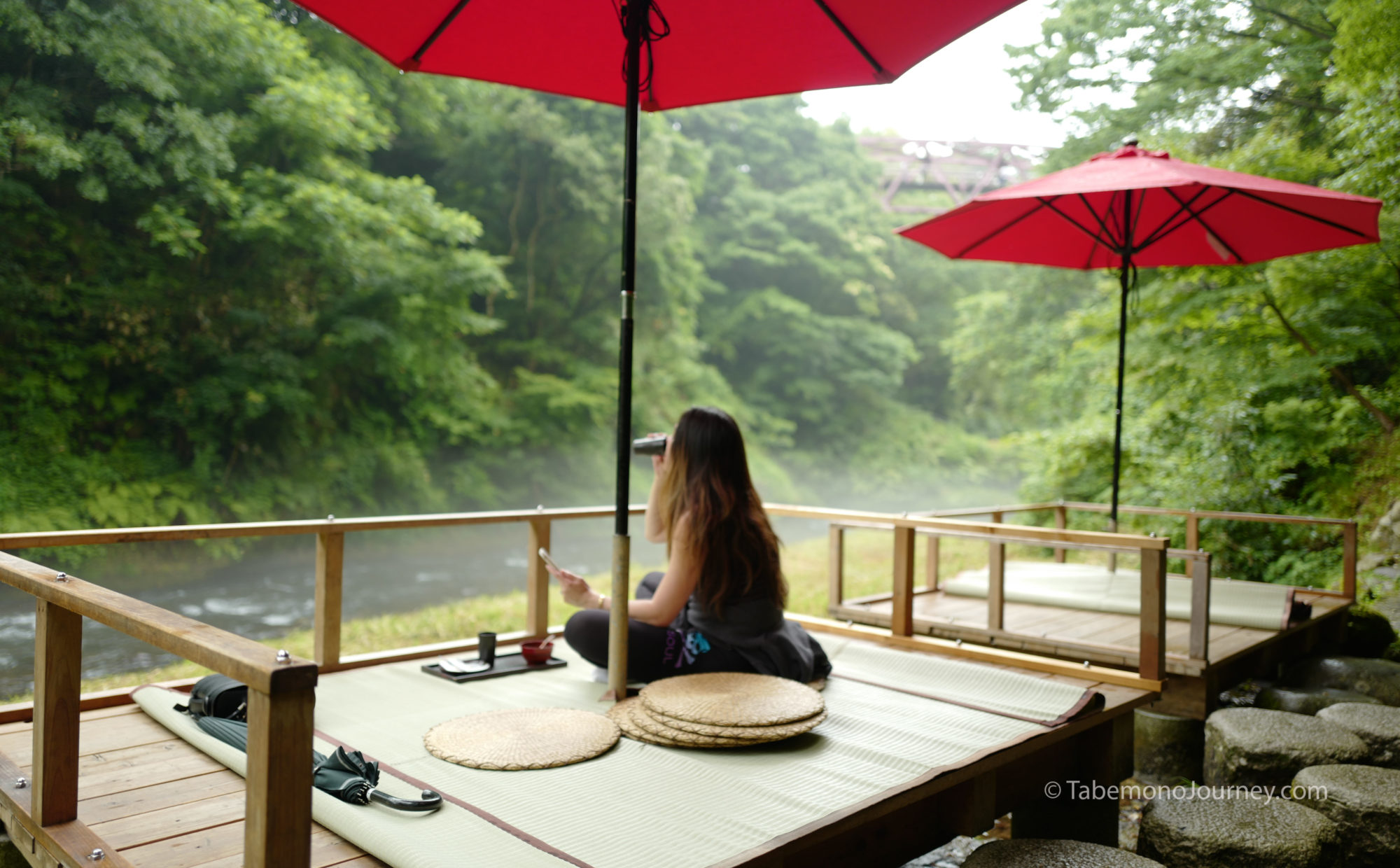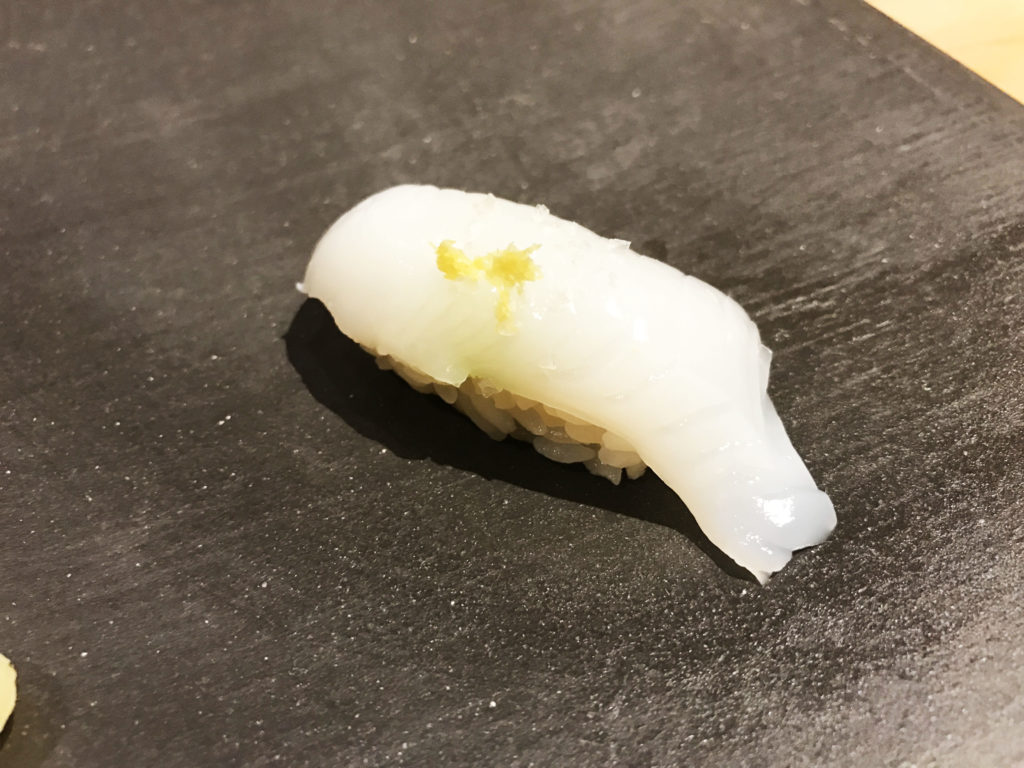
March 23, 2017
I have been a huge fan of Chef Masaki Sasaki since having him prepare sushi for me at the counter of Maruya. He is one of the few itamae (chefs) in San Francisco that can make sushi that rivals many of the high-end sushi places in Ginza, Tokyo.
I was disappointed when Chef Sasaki left Maruya, but I would see his name pop up in the media as he played consultant to many other sushi restaurants including Omakase, which eventually earned a Michelin Star. Ironically, Maruya lost their star the following year when both Chef Masaki Sasaki and Chef Hide Sueyoshi left. When I read that Chef Sasaki was finally opening his own restaurant, I was excited and planned a visit. During dinner service, I was able to talk with Chef Sasaki throughout our meal. He mentioned to me that one of the reasons he left Maruya was that he felt they wanted more fusion with kaiseki, while instead, he wanted to focus on Edomae style sushi.
For the those not familiar with Edomae sushi, it refers to sushi prepared in the style during the Edo period (1603-1868) which is the old name for Tokyo. During this time, there was no refrigeration technology, and as such, sushi had to have as long of a shelf-life as possible, since at the time, it was a fast food item sold in stalls. Many techniques were developed to prevent the raw ingredient from spoiling. One of the techniques included immersing in soy sauce (zuke) for a few hours which not only kept the fish from spoiling, but also preserved the texture of the raw ingredients. Other curing techniques include pouring hot water over the raw fish to “sear it” and then wrapping the fish in kombu which not only cures the fish but infuses it with umami from the seaweed. Yet, another technique included curing raw oily type fish with vinegar and salt, which not only favored the fish, but again preserved the raw texture. Additionally the vinegar in the shari is also another preservation method of the rice itself. Besides keeping the ingredients from spoiling, the chefs found an added side benefit where the taste and texture of the some of the fish and rice actually improved with these techniques. This formed the basis of Edo-style sushi or what is known as Edomae sushi.
This brings us back to Masaki Sasaki’s focus on Edomae and is one reason that most of his fish are aged through either curing, salting, smoking, or light pickling to enhance the flavors and textures of the fish. It is one of the reasons I was excited to have dinner at Sasaki. But even more impressive was the fact that Chef Sasaki uses two types of shari, one prepared with akazu (sake lees red vinegar) and kome-zu (rice vinegar), that he will match with different kinds of fish throughout the dinner course. Even in Japan, this is only done in a few restaurants.

I was fortunate to sit right in front of Chef Masa Sasaki during our service. It is bar counter only, just like many of the high-end Ginza sushi-ya. There is only one dinner service on weekdays and two seatings on the weekends (Friday through Sunday). As with most omakase sushi places, the ingredients will change based on seasonality, but you are served five otsumami course followed by 13 pieces of nigiri. The meal then wraps up with a red miso soup and dessert.
 Our meal started with a tiny box from the get go when we arrived. In there was boiled octopus which was a great way to start our meal.
Our meal started with a tiny box from the get go when we arrived. In there was boiled octopus which was a great way to start our meal.
 A beautifully prepared zuke maguro nigiri. He served this as part of the tsunami course which I really liked as it gave prelude to what to expect from the nigiri course. The zuke curing technique gives the akami of the tuna a buttery, melt in your mouth texture.
A beautifully prepared zuke maguro nigiri. He served this as part of the tsunami course which I really liked as it gave prelude to what to expect from the nigiri course. The zuke curing technique gives the akami of the tuna a buttery, melt in your mouth texture.
 Sawada that was lightly boiled on then cured. Paired with baby daikon sprouts and served with a light ponzu with dashi dressing.
Sawada that was lightly boiled on then cured. Paired with baby daikon sprouts and served with a light ponzu with dashi dressing.
 Simmered octopus with a house tsume sauce and spicy mustard. The textured was soft and whole tentacles of the octopus was sliced right in front of you. Really enjoyed the tsume sauce paired with the mustard.
Simmered octopus with a house tsume sauce and spicy mustard. The textured was soft and whole tentacles of the octopus was sliced right in front of you. Really enjoyed the tsume sauce paired with the mustard.
 Cured Madai (sea bream) with gomae dressing. Gomae is sesame seed dressing and thought it would overpower the dish, but it was actually excellently balanced to allow the fish to still be the star of the course.
Cured Madai (sea bream) with gomae dressing. Gomae is sesame seed dressing and thought it would overpower the dish, but it was actually excellently balanced to allow the fish to still be the star of the course.
 Shirako from the Medai was being prepared for us. If you don’t know what this is…it’s the male counterpart of roe.
Shirako from the Medai was being prepared for us. If you don’t know what this is…it’s the male counterpart of roe.
 Fully prepared, and it was one of the best preparation I had in the United States and Japan. The taste can only be described as very clean as the madai was from the seas of Japan and the clean waters influence the taste of the organs of the fish. It was lightly poached and had the texture of uni. One of the best preparations of shirako I have had.
Fully prepared, and it was one of the best preparation I had in the United States and Japan. The taste can only be described as very clean as the madai was from the seas of Japan and the clean waters influence the taste of the organs of the fish. It was lightly poached and had the texture of uni. One of the best preparations of shirako I have had.
The nigiri courses started next with a series of fish that uses shari that was made with akazu (red vinegar, made from sake lees) shari. As you watch him mold the sushi, you will notice that he compresses the shari (sushi rice) three times in fluid motions. This hand technique is called kotegaeshi and is used mainly by classically trained sushi chefs native to Japan. This hand technique is important in high-end sushi for two reasons. The first is that you do not want the warm temperature of the hands to change the temperature of the rice and neta (sliced fish). Secondly, you do not want the rice to be overworked as you want an air pocket in the middle of the rice ball, yet you do not want the rice to break apart prior to putting it in your mouth. This step is vital as it will allow the shari to “dance” in your mouth as it breaks apart. In some circles, the shari preparation and execution is maybe more important than the neta.
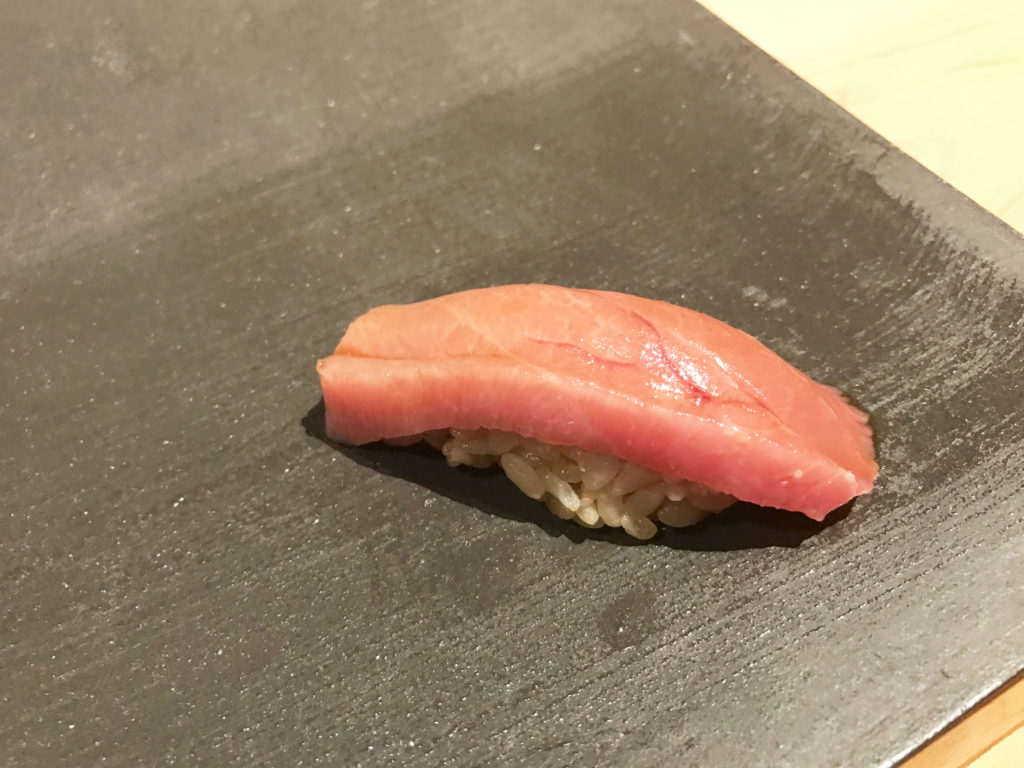 Chu toro just melts in your mouth. The tsume glaze was nicely layered to provide a savory balance to this fatty and robust cut.
Chu toro just melts in your mouth. The tsume glaze was nicely layered to provide a savory balance to this fatty and robust cut.
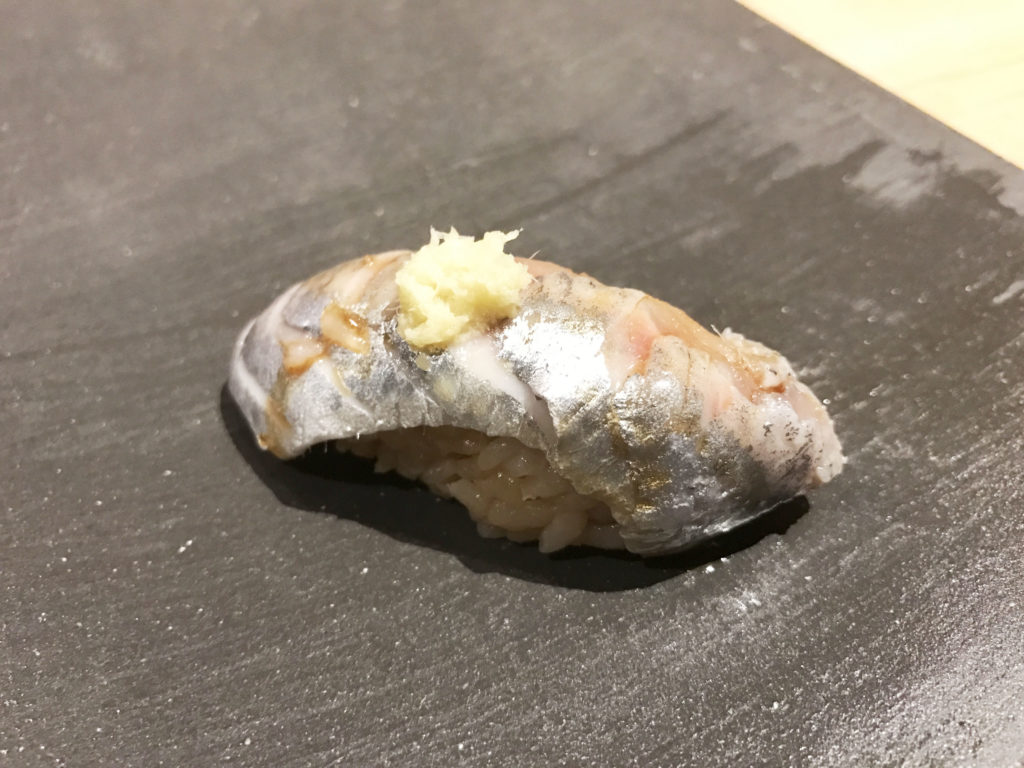 My favorite of the night was iwashi (sardine). Notice the vertical scoring throughout the neta that allowed a perfect mold to the shari. Besides looking nice, it allows additional soft texture to the fish.
My favorite of the night was iwashi (sardine). Notice the vertical scoring throughout the neta that allowed a perfect mold to the shari. Besides looking nice, it allows additional soft texture to the fish.
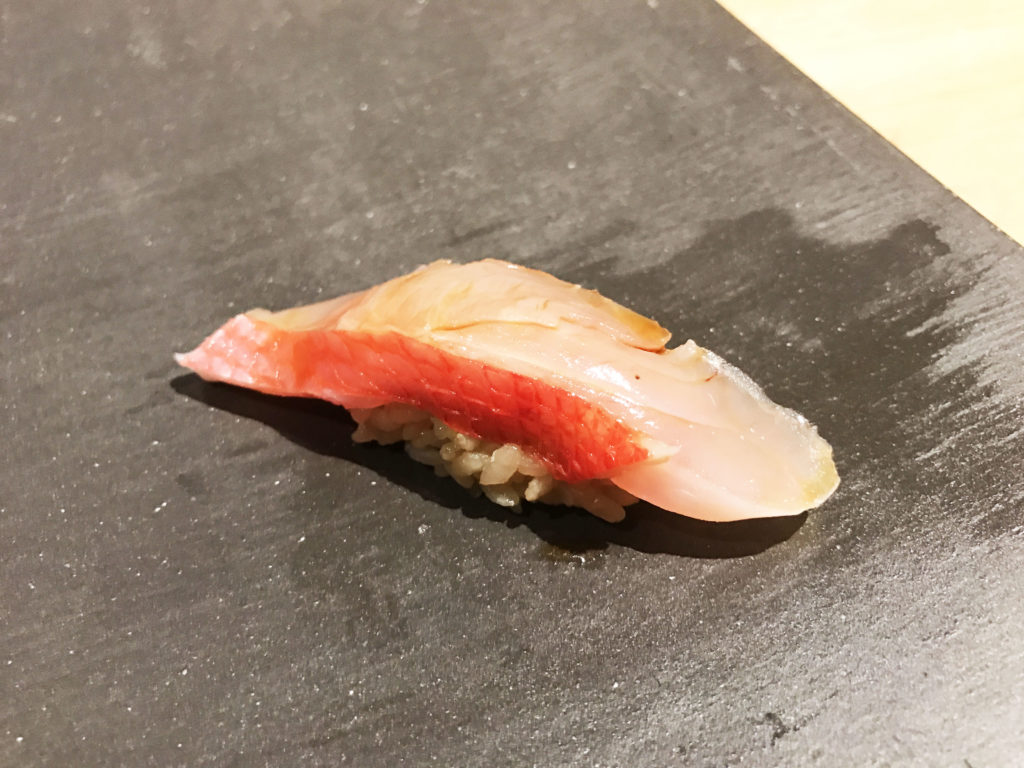 Kinmedai was cured and most likely used a hot water sear method instead of a torch method.
Kinmedai was cured and most likely used a hot water sear method instead of a torch method.
 Aji was paired with ume. Never had horse mackerel sushi with ume (plum sauce) but it worked.
Aji was paired with ume. Never had horse mackerel sushi with ume (plum sauce) but it worked.
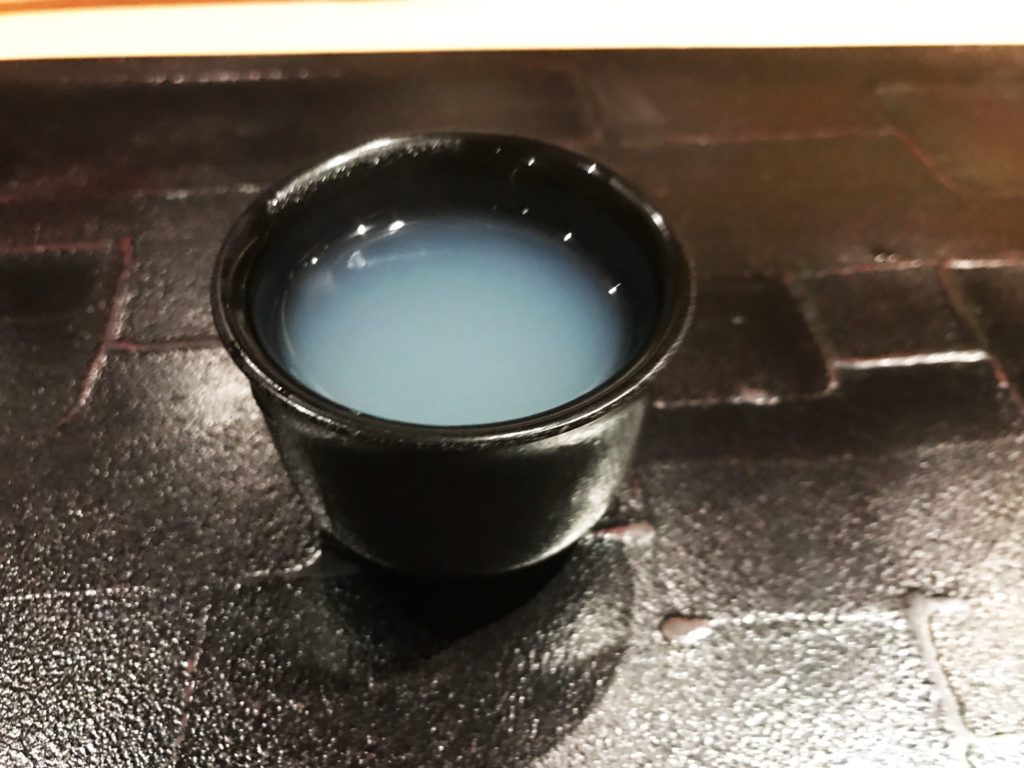 Asari no sumashijiru (clam clear soup) to cleanse the palate. It helped to get us ready for the change in shari made with the kome-zu.
Asari no sumashijiru (clam clear soup) to cleanse the palate. It helped to get us ready for the change in shari made with the kome-zu.
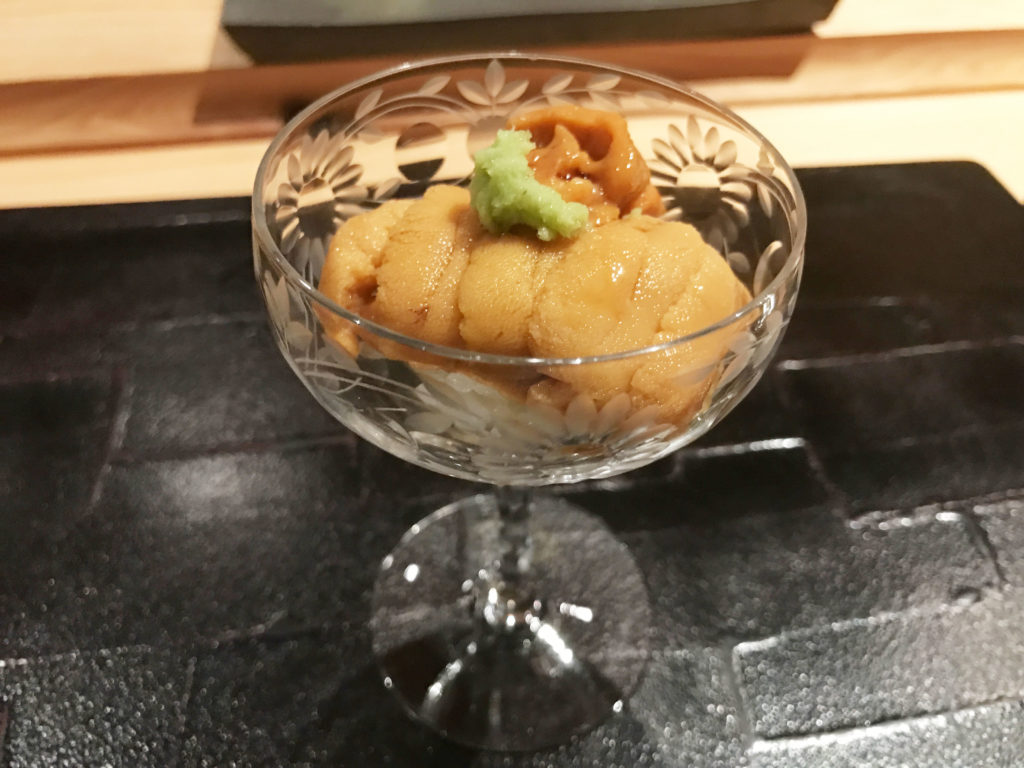 Excellent bafun uni from Hokkaido prepared in a glass with the kome-zu shari at the bottom.
Excellent bafun uni from Hokkaido prepared in a glass with the kome-zu shari at the bottom.
Ika was very good and expertly prepared due to the scoring work on the squid.
 Kanpachi nigiri which is amberjack.
Kanpachi nigiri which is amberjack.
 Sayori was very good. This was one fish I like when it’s just prepared and cut, but Chef Sasaki did some curing method, that really subtlety enhanced the flavor of the fish.
Sayori was very good. This was one fish I like when it’s just prepared and cut, but Chef Sasaki did some curing method, that really subtlety enhanced the flavor of the fish.
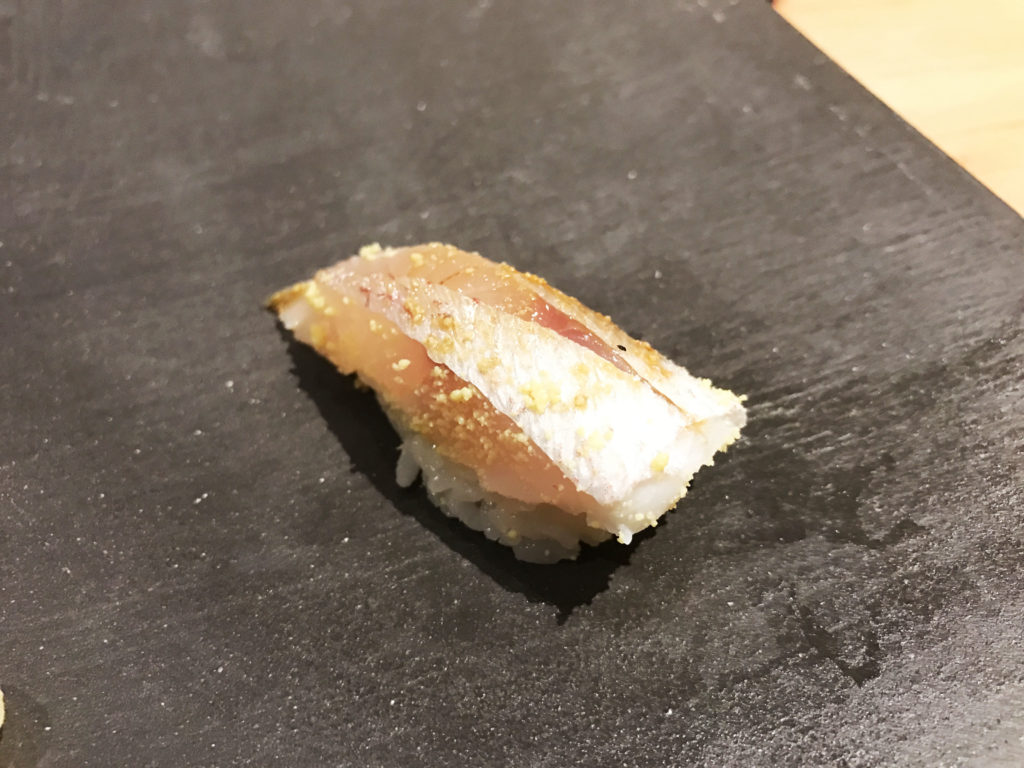 Kasuodai (young sea bream) that was cured in combo and then rolled with egg yolk, it was another favorite of the night for me.
Kasuodai (young sea bream) that was cured in combo and then rolled with egg yolk, it was another favorite of the night for me.
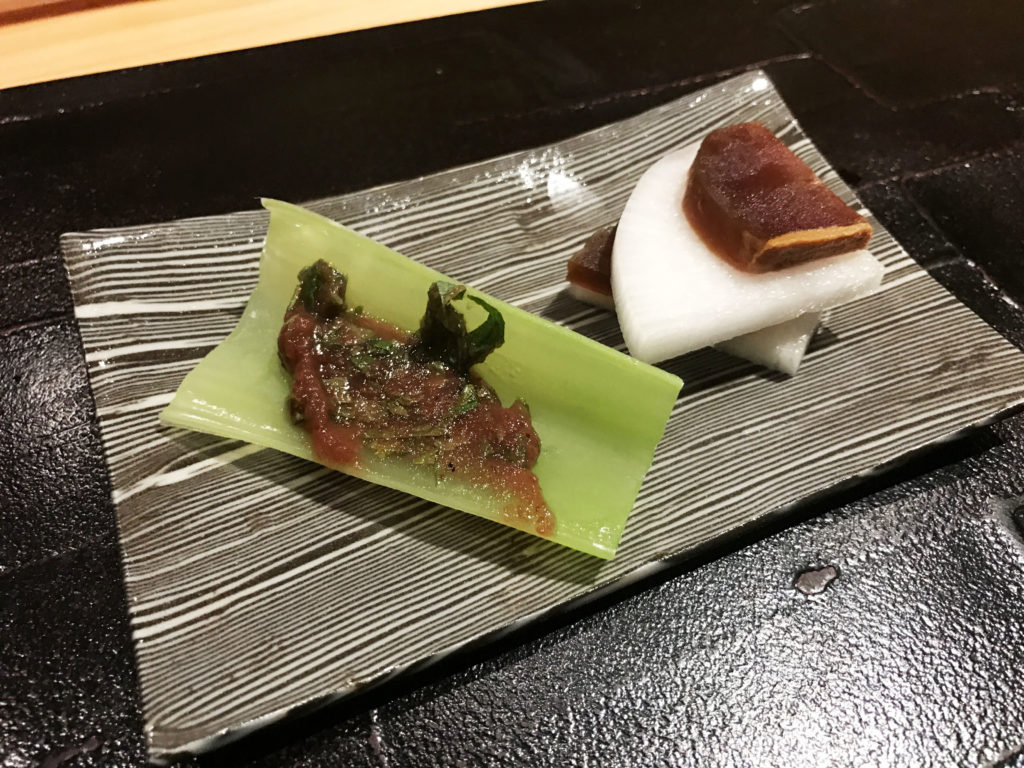 We had another palate cleanser, which Chef Sasaki explained, focuses on the alkalinity from a “ph” persperspective to help cleanse our palate as he which back to the more acidic aka-zu shari. He gave us nara zuke, which are brown pickles from Nara, Japan paired with daikon slices and a miso preparation on boiled celery.
We had another palate cleanser, which Chef Sasaki explained, focuses on the alkalinity from a “ph” persperspective to help cleanse our palate as he which back to the more acidic aka-zu shari. He gave us nara zuke, which are brown pickles from Nara, Japan paired with daikon slices and a miso preparation on boiled celery.
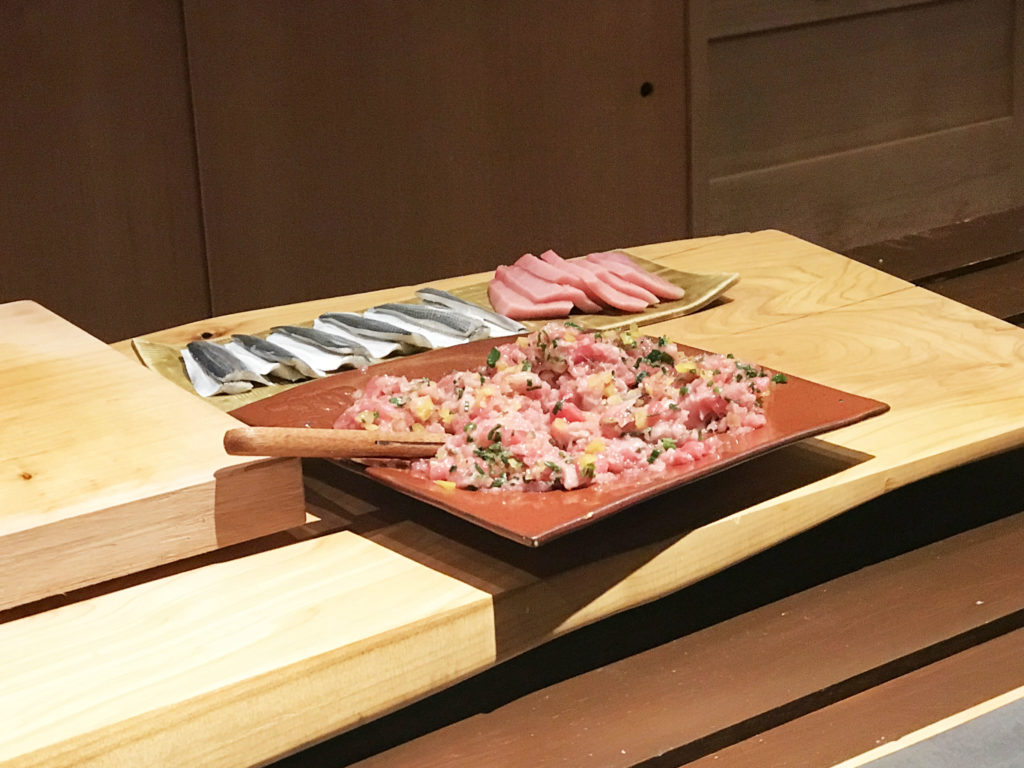 The three items were being prepared and I noticed that the aka-zu was brought back. This time I noticed that the shari was slightly warmer than previously.
The three items were being prepared and I noticed that the aka-zu was brought back. This time I noticed that the shari was slightly warmer than previously.
 O-toro nigiri which is the fatty portion of the tuna was delicious.
O-toro nigiri which is the fatty portion of the tuna was delicious.
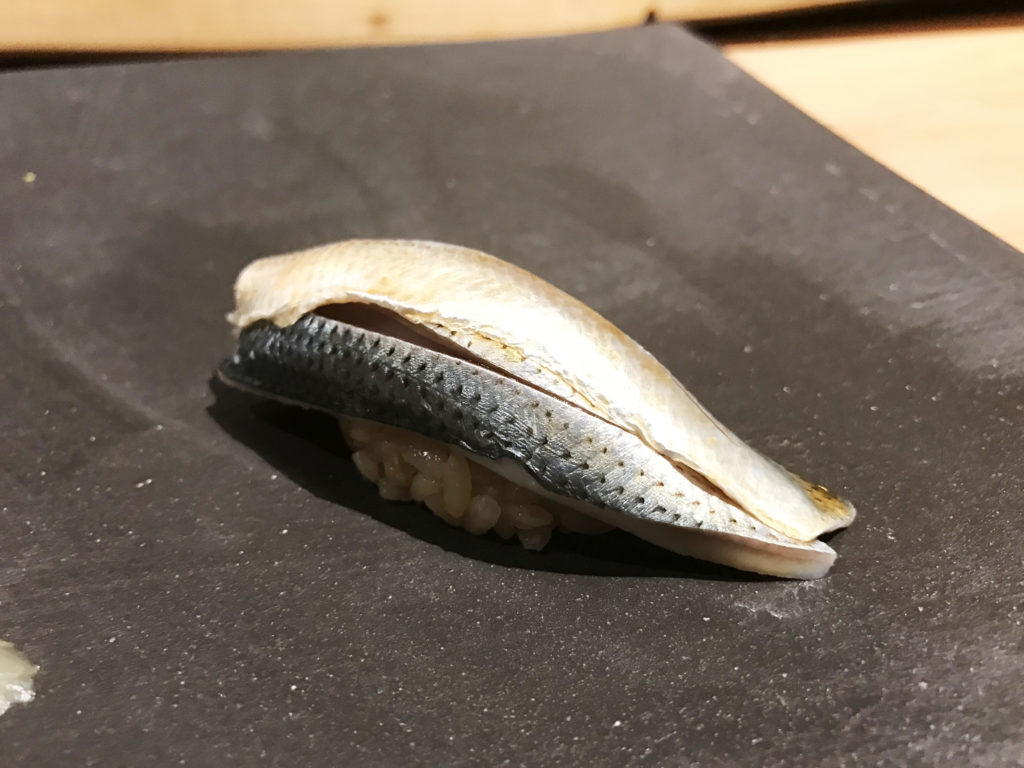 Kohada is my favorite nigiri in general. The shad gizzard is a true test of any itamae as the fat content changes with the season so the vinegar and salt curing technique and application is a testament to their experience. If you over season the fish, you lose the raw texture, and if you under season you get too fishy of a taste. Chef sasaki passes with flying color.
Kohada is my favorite nigiri in general. The shad gizzard is a true test of any itamae as the fat content changes with the season so the vinegar and salt curing technique and application is a testament to their experience. If you over season the fish, you lose the raw texture, and if you under season you get too fishy of a taste. Chef sasaki passes with flying color.
 Buttery soft, the boiled anago (conger eel) with sansho pepper salt. I usually see this topped with tsume sauce, but this preparation was just as good and really focused on the fish.
Buttery soft, the boiled anago (conger eel) with sansho pepper salt. I usually see this topped with tsume sauce, but this preparation was just as good and really focused on the fish.
 Maki made with negi, toro, and bits of pickled daikon finishes up the “raw” portion of our meal.
Maki made with negi, toro, and bits of pickled daikon finishes up the “raw” portion of our meal.
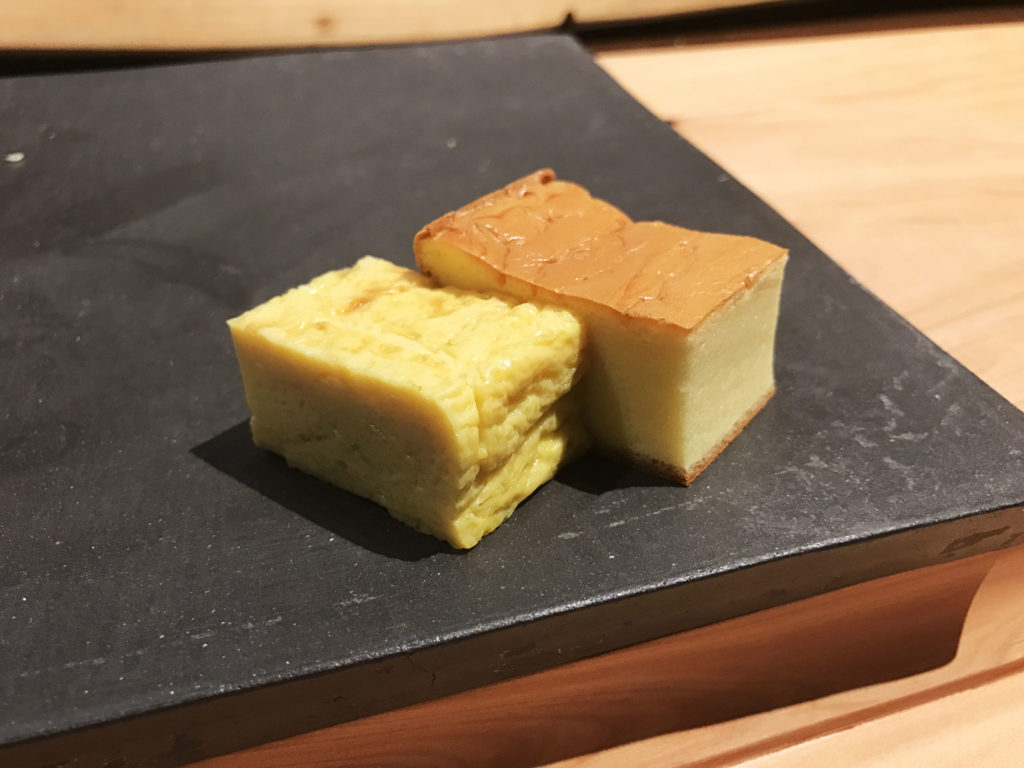 Two types of tamago, one that’s the classic cake like an another more traditionally layered with dashi mixed in.
Two types of tamago, one that’s the classic cake like an another more traditionally layered with dashi mixed in.
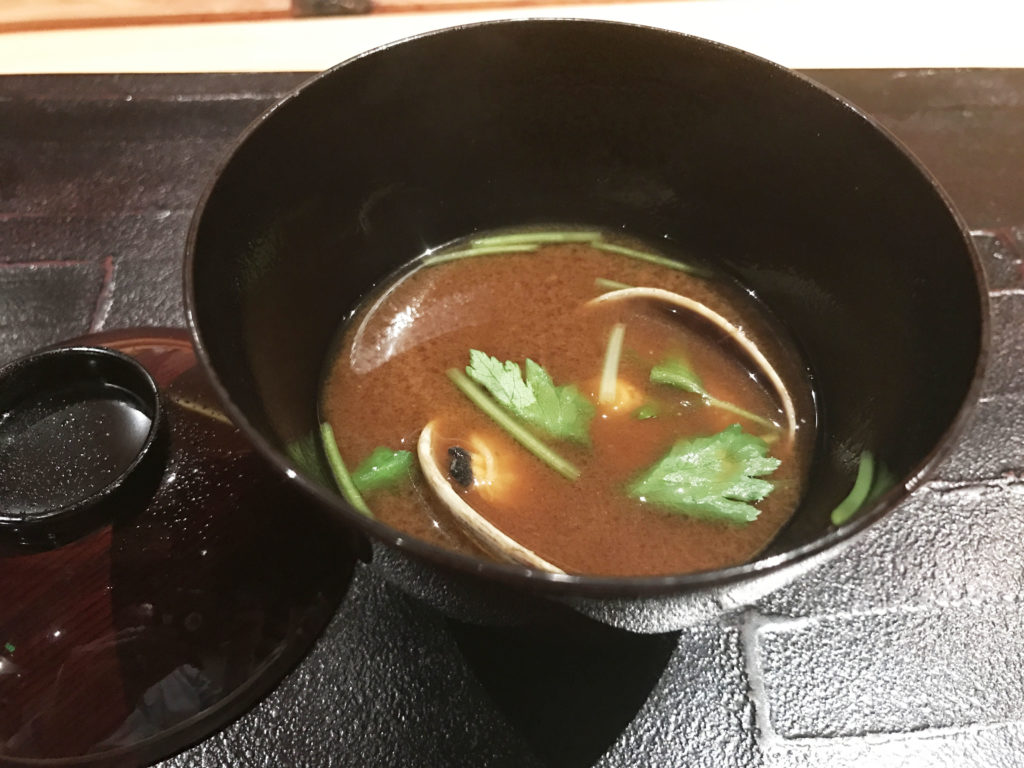 Aka (red) miso soup with manila clam and mitsubishi leaf wrapped up the dinner portion of our meal.
Aka (red) miso soup with manila clam and mitsubishi leaf wrapped up the dinner portion of our meal.
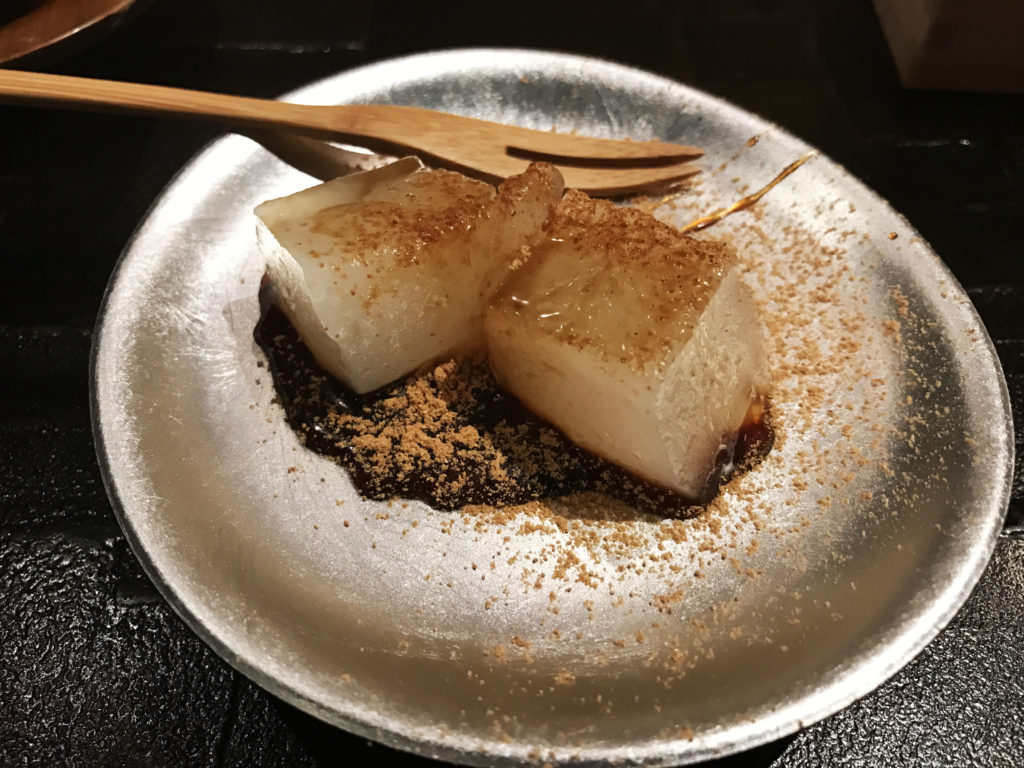 Classically prepared warabi which is water mochi was our dessert.
Classically prepared warabi which is water mochi was our dessert.
 Dinner was amazing, and I had a wonderful time talking with Chef Sasaki throughout the night. His dedication and passion to sushi were highlighted throughout the night and with comments such as “sushi is not just about slicing fish, it requires aging, curing, and marinating” and “it’s a pain” when I noted the use of two different rice but with a proud smile on his face. Recently, San Francisco had so many counter-style sushi restaurants that had opened in the past several years. While many have been good, really great sushi just has not been available…until now.
Dinner was amazing, and I had a wonderful time talking with Chef Sasaki throughout the night. His dedication and passion to sushi were highlighted throughout the night and with comments such as “sushi is not just about slicing fish, it requires aging, curing, and marinating” and “it’s a pain” when I noted the use of two different rice but with a proud smile on his face. Recently, San Francisco had so many counter-style sushi restaurants that had opened in the past several years. While many have been good, really great sushi just has not been available…until now.
